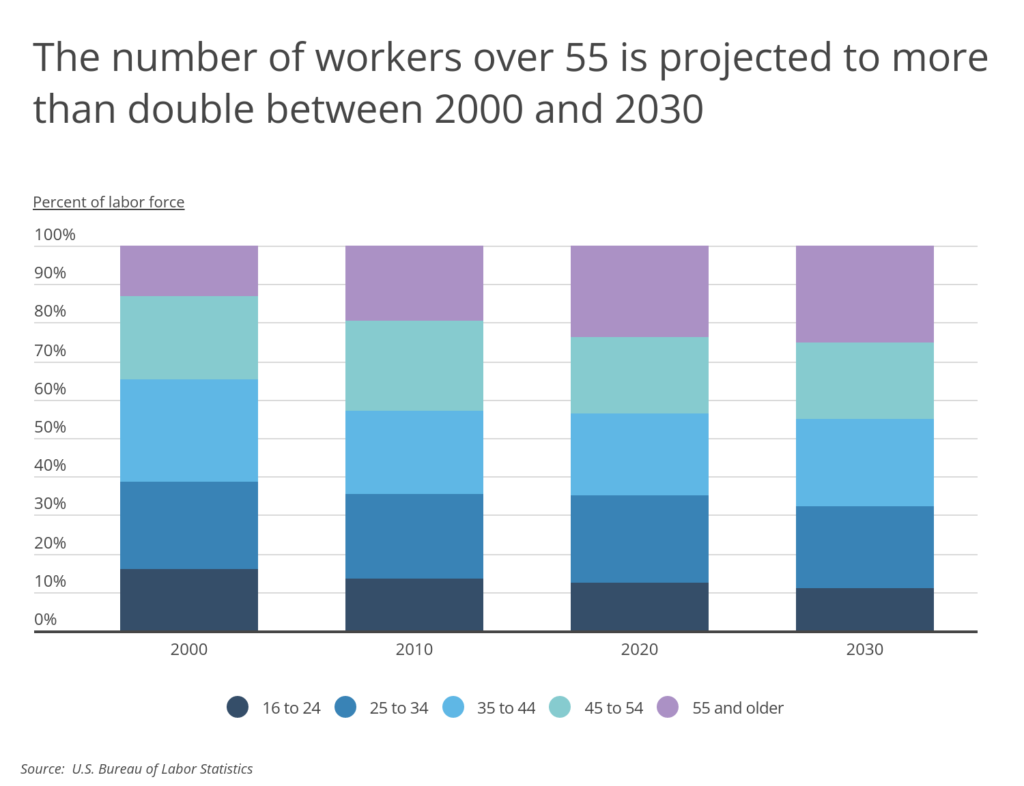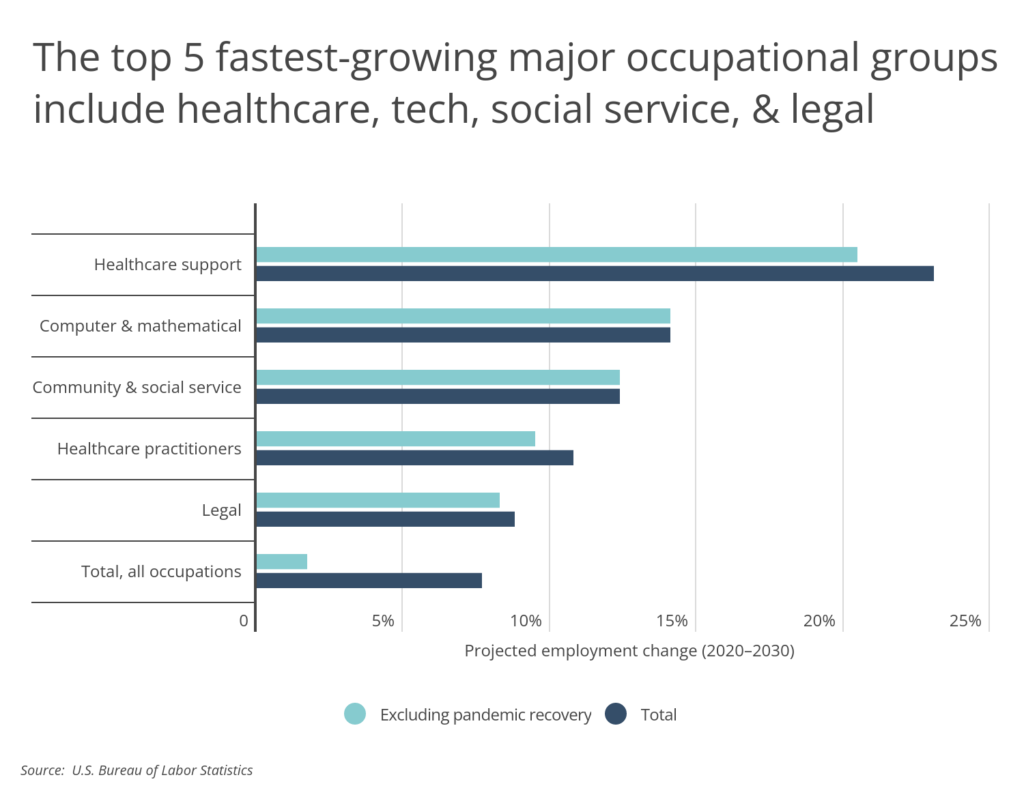Occupations Expected to Grow the Most Over the Next Decade in the U.S.
The COVID-19 pandemic has dramatically reshaped the U.S. labor market in many ways. Many low-wage jobs in fields like retail and hospitality were lost early in the pandemic and have not come back, while throughout the pandemic, there has been strong demand for health workers in response to the pandemic and technology specialists who can support an increasingly virtual economy. The unemployment rate remains elevated, but many industries are facing labor shortages and millions of workers have been leaving their jobs voluntarily in a phenomenon that has come to be known as “The Great Resignation.”
In some cases, the pandemic has been an accelerant of labor trends that were already underway, like increasing automation and digitalization of jobs. In others, post-pandemic shifts in the labor force will have less to do with the effects of the pandemic than with underlying demographic and economic trends. This complicated set of factors is evident in recent projections from the Bureau of Labor Statistics, which estimated that total U.S. employment will grow 7.7% between now and 2030-but only by 1.7% when excluding the economy’s recovery from pandemic-related job loss.
One of the demographic trends driving shifts in the workforce is the aging of the population. The Baby Boomers, those Americans born between 1946 and 1964, number more than 75 million and were the largest generation in U.S. history until the Millennials came along. The Boomers have until recently tended to represent the largest sections of the labor force and are working later into life than previous generations. As a result, those aged 55+ are expected to represent around a quarter of the workforce for at least the next decade.

TRENDING ON SMARTEST DOLLAR
One of the most important types of small business insurance for companies that manufacture or sell physical goods is product liability insurance. Product liability insurance provides legal protection in the event that someone pursues a lawsuit relating to a defective product.
But the aging of the Baby Boomer generation will have more widespread effects on jobs and the economy as well. Eventually, as this generation ages out of the workforce into retirement, more companies will have vacancies and potentially find themselves struggling to fill positions that the Boomers once occupied. This scenario will put pressure on many employers but could also position younger workers for greater job opportunities. A larger population of elderly Americans will also bring greater strains on healthcare, so more of the economy will need to be oriented around supporting older Americans in their later years of life.
The latter trend is one of the primary reasons why health and human service occupations are projected to be among the fastest-growing fields in the years ahead. Healthcare support jobs are the top field for growth, with a total projected growth rate of 23.1% between 2020 and 2030. The related fields of community and social service and healthcare practitioners are also near the top of the list, with growth rates of 12.4% and 10.8%, respectively.

RELATED
As the healthcare industry continues to grow, so too will the need for professional liability insurance. The best professional liability insurance companies will protect businesses or individuals that offer services from liability suits made against them by a client, customer, or patient.
One of the other major growth fields is computer and mathematical positions, a category that includes professions like programming, data science, software development, and network and systems administration. As more of society and the economy become dependent on technology, these positions are poised for rapid growth. In addition to good job prospects, computer and mathematical positions also offer some of the best compensation of any occupational group, with a median wage of more than $91,000.
At the individual occupation level, health-related and technology-related professions are unsurprisingly among the fastest-growing. But two of the top three individual occupations for growth are in the lower-growth category of installation, maintenance, and repair occupations: wind turbine service technicians and solar photovoltaic installers. The field of renewable energy has seen significant growth in recent years and is likely to continue as the costs of renewables decline, consumer demand increases, and the transition to lower-carbon energy sources takes on greater urgency. For job-seekers interested in reliable jobs and growth opportunities in the years ahead, a career in wind or solar energy may be one of the best options out there.
The data used in this analysis is from the U.S. Bureau of Labor Statistics Employment Projections program. To identify the fastest growing occupations over the next decade, researchers at Smartest Dollar reported the projected percentage change in employment between 2020 and 2030, excluding occupations with greater-than-average drops in employment due to the COVID-19 pandemic.
Here are the occupations expected to grow the most over the next decade.
The Fastest-Growing Jobs Between 2020 & 2030

Photo Credit: mojo cp / Shutterstock
15. Computer numerically controlled tool programmers
- Projected employment change (percent): 27.4%
- Projected employment change (total): 7,400
- Employment (2020): 27,100
- Employment (2030): 34,500
- Median annual wage (2020): $57,740
- Typical education needed for entry: Postsecondary nondegree award

Photo Credit: mezzotint / Shutterstock
14. Animal trainers
- Projected employment change (percent): 28.5%
- Projected employment change (total): 17,200
- Employment (2020): 60,200
- Employment (2030): 77,400
- Median annual wage (2020): $31,520
- Typical education needed for entry: High school diploma or equivalent
TRENDING
Do you have family members or other individuals that depend on you, either financially or otherwise? If so, it’s important to have adequate life insurance coverage. The best life insurance companies will provide your family and dependents with financial security at an affordable price.

Photo Credit: fizkes / Shutterstock
13. Speech-language pathologists
- Projected employment change (percent): 28.7%
- Projected employment change (total): 45,400
- Employment (2020): 158,100
- Employment (2030): 203,500
- Median annual wage (2020): $80,480
- Typical education needed for entry: Master’s degree

Photo Credit: Kzenon / Shutterstock
12. Logisticians
- Projected employment change (percent): 29.5%
- Projected employment change (total): 56,400
- Employment (2020): 191,000
- Employment (2030): 247,300
- Median annual wage (2020): $76,270
- Typical education needed for entry: Bachelor’s degree

Photo Credit: anyaivanova / Shutterstock
11. Epidemiologists
- Projected employment change (percent): 29.6%
- Projected employment change (total): 2,300
- Employment (2020): 7,800
- Employment (2030): 10,200
- Median annual wage (2020): $74,560
- Typical education needed for entry: Master’s degree

Photo Credit: Stokkete / Shutterstock
10. Physician assistants
- Projected employment change (percent): 31.0%
- Projected employment change (total): 40,100
- Employment (2020): 129,400
- Employment (2030): 169,500
- Median annual wage (2020): $115,390
- Typical education needed for entry: Master’s degree

Photo Credit: Andrey_Popov / Shutterstock
9. Data scientists and mathematical science occupations
- Projected employment change (percent): 31.4%
- Projected employment change (total): 19,800
- Employment (2020): 63,200
- Employment (2030): 83,000
- Median annual wage (2020): $98,230
- Typical education needed for entry: Bachelor’s degree

Photo Credit: Monkey Business Images / Shutterstock
8. Medical and health services managers
- Projected employment change (percent): 32.5%
- Projected employment change (total): 139,600
- Employment (2020): 429,800
- Employment (2030): 569,400
- Median annual wage (2020): $104,280
- Typical education needed for entry: Bachelor’s degree

Photo Credit: Dmytro Zinkevych / Shutterstock
7. Home health and personal care aides
- Projected employment change (percent): 32.6%
- Projected employment change (total): 1,129,900
- Employment (2020): 3,470,700
- Employment (2030): 4,600,600
- Median annual wage (2020): $27,080
- Typical education needed for entry: High school diploma or equivalent

Photo Credit: SFIO CRACHO / Shutterstock
6. Information security analysts
- Projected employment change (percent): 33.3%
- Projected employment change (total): 47,100
- Employment (2020): 141,200
- Employment (2030): 188,300
- Median annual wage (2020): $103,590
- Typical education needed for entry: Bachelor’s degree

Photo Credit: MIND AND I / Shutterstock
5. Statisticians
- Projected employment change (percent): 35.4%
- Projected employment change (total): 14,900
- Employment (2020): 42,000
- Employment (2030): 56,900
- Median annual wage (2020): $92,270
- Typical education needed for entry: Master’s degree

Photo Credit: Photographee.eu / Shutterstock
4. Physical therapist assistants
- Projected employment change (percent): 35.4%
- Projected employment change (total): 33,200
- Employment (2020): 93,800
- Employment (2030): 126,900
- Median annual wage (2020): $59,770
- Typical education needed for entry: Associate’s degree

Photo Credit: anatoliy gleb / Shutterstock
3. Solar photovoltaic installers
- Projected employment change (percent): 52.1%
- Projected employment change (total): 6,100
- Employment (2020): 11,800
- Employment (2030): 17,900
- Median annual wage (2020): $46,470
- Typical education needed for entry: High school diploma or equivalent

Photo Credit: Monkey Business Images / Shutterstock
2. Nurse practitioners
- Projected employment change (percent): 52.2%
- Projected employment change (total): 114,900
- Employment (2020): 220,300
- Employment (2030): 335,200
- Median annual wage (2020): $111,680
- Typical education needed for entry: Master’s degree

Photo Credit: Aunging / Shutterstock
1. Wind turbine service technicians
- Projected employment change (percent): 68.2%
- Projected employment change (total): 4,700
- Employment (2020): 6,900
- Employment (2030): 11,700
- Median annual wage (2020): $56,230
- Typical education needed for entry: Postsecondary nondegree award
Methodology & Detailed Findings
The data used in this analysis is from the U.S. Bureau of Labor Statistics Employment Projections program. To identify the fastest growing occupations over the next decade, researchers reported the projected percentage change in employment between 2020 and 2030, excluding occupations with greater-than-average drops in employment due to the COVID-19 pandemic. Only the top 30 occupations with the fastest growth were included in the analysis.
By clicking the above links, you will go to one of our insurance partners. The specific companies listed above may not be included in our partner's network at this time.
